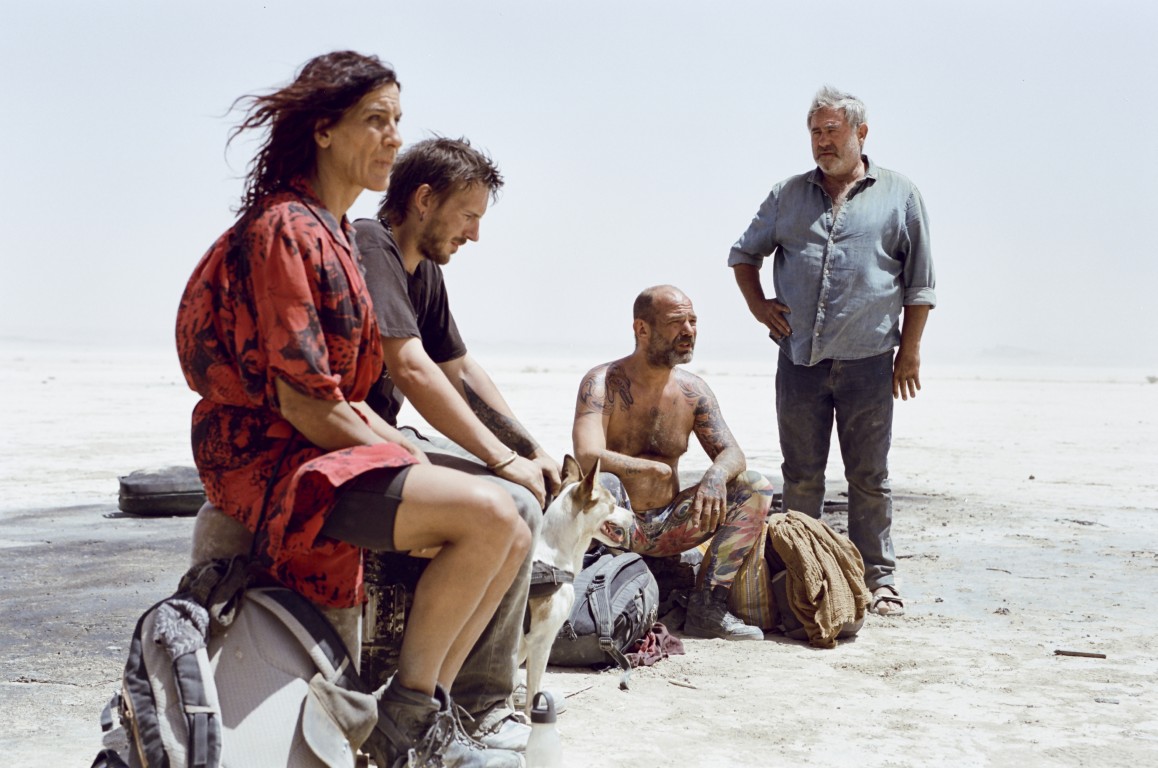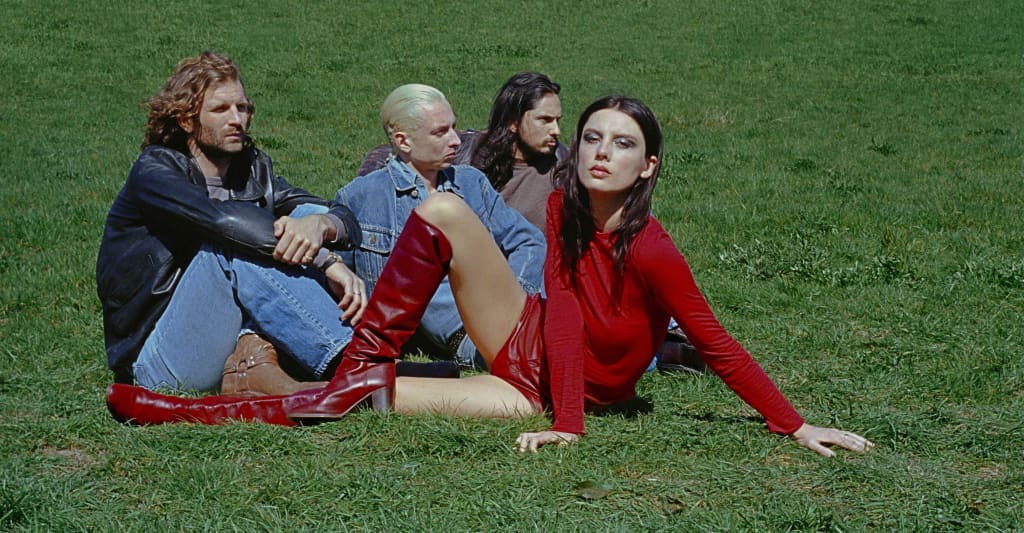Cannes 2025: Left-Handed Girl, Sirât
Today's dispatch includes a Sean Baker production and the latest from Oliver Laxe.

Sean Baker, the winner of last year’s Palme d’Or (and four Oscars) for “Anora,” already has a new film at Cannes—sort of. “Left-Handed Girl,” in Critics’ Week, was directed by Shih-Ching Tsou, Baker’s collaborator of more than two decades. Together, they wrote and directed their first feature, “Take Out” (2004). Tsou has produced several of Baker’s films and sometimes acted in them. (She plays the woman who runs the donut shops in both “Tangerine” and “Red Rocket.”)
“Left-Handed Girl” is her first solo directorial feature, but Baker wrote it with her and edited it. So on one hand, comparing it to Baker’s movies is unfair, especially since “Left-Handed Girl,” which concerns a family of three in Taiwan, is doing its own thing, wonderfully. On the other hand, commonalities are inevitable. The movie often feels like a Baker film in its jangling comic chaos (notably a bit involving a pet meerkat) and in the scenes involving the title character, a bundle of mischief who recalls Moonee, the girl from “The Florida Project.”
Shot on iPhones (though looking much snazzier than “Tangerine”), “Left-Handed Girl” begins with the main characters—mom Shu-Fen (Janel Tsai), daughters I-Ann (Shih-Yuan Ma) and I-Jing (Nina Ye)—moving back to Taipei, into an apartment that one complains looked bigger in a photo. They’ve been away for some years for a variety of reasons. Shu-Fen opens a noodle stand at a night market, where the youngest, I-Jing, runs around without the burden of adult supervision. I-Ann, who is older and more rebellious (a friend remarks that she’s changed a lot since high school, when she was a straight-A student), takes a job of her own and soon begins an affair with her boss.
I-Jing is left-handed, which most people don’t think is a big deal. But her grandfather, who takes umbrage whenever he watches her eat, believes that it’s “the devil’s hand” and shouldn’t be used. I-Jing has a limited understanding of this superstition. She sometimes tries to keep her devil hand in check (there’s a horrifying shot in which she ponders amputation), but she also reasons, with her impeccable child’s logic, that the hand can be put to good use—or at least that it has a mind of its own.
There’s a lot going along the story’s periphery, and the brisk, nervy cutting relays some important details quickly. Early on, we learn that Shu-Fen’s barely glimpsed husband, who walked out on the family, is ailing. When he dies, the women inherit his meerkat—which I-Jing delights in playing with—but his funeral becomes an unexpected expense that leaves Shu-Fen strapped to pay the rent for the noodle stall. As in Baker’s films, economic hardship is never overstated as an issue, but is also never far from view. Even the pint-size I-Jing begins thinking about what she can sell to a pawn shop.
It is difficult to discuss “Left-Handed Girl” without giving away its many twists and turns. Suffice it to say that despite its warmth and humor, some bitter undercurrents emerge, and what in the opening scenes seems like casual observation turns out to be a sharply etched character study. I look forward to watching it again with foreknowledge of where the story ends.

One of the pleasures of attending Cannes is encountering a film so out-there that you’re not entirely sure how to process it. For me, that’s the case with “Sirât,” a hallucinatory, horrifying, and wholly unexpected competition entry from the Paris-born Galician filmmaker Oliver Laxe.
Laxe has had a winding road to the competition. His “Mimosas” won the top prize at Critics’ Week in 2016, and his “Fire Will Come” showed in Un Certain Regard in 2019. But anyone familiar with those minimalist exercises will be stunned at where Laxe goes with a (relatively) larger budget. “Sirât” is proudly an arthouse film, unafraid to be cryptic, in a tradition that has echoes of Claire Denis (particularly “Beau Travail”) and Michelangelo Antonioni. But the movie also at various points evokes “Mad Max” and “The Wages of Fear” in the mechanics of its suspense, in its grime, and in its portrait of a life-altering journey with cosmic stakes.
The title, opening text explains, refers to a bridge that connects hell and paradise. The film opens by watching men set up for a rave in the Moroccan desert. Then it spends a long sequence simply letting viewers settle into the backbeat. Clearly out of place in the grooving crowd is Luis (Sergi López), who is there with his young son, Esteban (Brúno Nuñez). They’re looking for his daughter, an itinerant ravegoer who has disappeared. He connects with a group of grungy partiers who tell him that they haven’t seen her, but that there’s another rave planned. Maybe she’ll be there.
Suddenly, men who appear to be military arrive and declare an emergency, shutting down the party and leading everybody away. Luis’s new friends cause a distraction, break off from the soldier-led caravan, and escape into the vast rocky landscape. On impulse, Luis and Esteban follow.
This group will remain together for the rest of the trek, although the movie leaves unresolved questions about whether anyone can be trusted and exactly where they’re going—the anticipated rave is somewhere far to the south, near the Mauritanian border (and therefore across the Sahara). It’s also unclear how long the trip will take and whether the group will have enough food and gas to get there.
Is it incumbent on Luis and Esteban to share their provisions? More importantly, do the strangers even know what they’re doing? This crew is more about altered states of mind than logistics. In an alarming development, Luis and Esteban’s dog, whom one dearly hopes is getting enough water to drink, becomes ill from accidentally ingesting residual LSD. But it’s not all hazards: In a lovely scene, one of the ravegoers, Jade (Jade Oukid), teaches Luis about the beauty and specificity of listening to music from slightly damaged speakers.
Luis is warned that his car may not be equipped to cross the terrain. A relatively early sequence in which the vehicle floods while being towed across a river is just a warmup for the terrors and shocks that transpire on the mountainous dirt roads.
“Sirât” is not afraid to throw viewers for a loop structurally, and there are some plot developments so cruel that they are hard to forgive, as much as they seem to fit the film’s design. At one point, a man crosses a minefield without trying to think too hard about it. On some level, that mirrors Laxe’s approach. He’s ventured into dangerous territory and emerged on the other side with something strange, primal, and haunting.



















![How to make Developer Friends When You Don't Live in Silicon Valley, with Iraqi Engineer Code;Life [Podcast #172]](https://cdn.hashnode.com/res/hashnode/image/upload/v1747360508340/f07040cd-3eeb-443c-b4fb-370f6a4a14da.png?#)
















































![Ben Foster Has a Macabre Obsession in New 'Sharp Corner' Sneak Peek [Exclusive]](https://static1.colliderimages.com/wordpress/wp-content/uploads/2024/09/sharp-corner_still_01.jpg?#)




